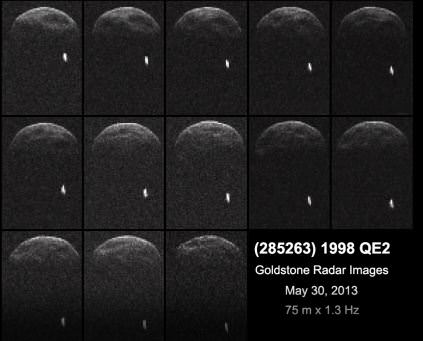Late yesterday, NASA turned the 230-foot (70-meter) Deep Space Network antenna at Goldstone, California towards Asteroid 1998 QE2 as it was heading towards its closest approach to Earth, and they got a big surprise: the asteroid is a binary system. 1998 QE2 itself is 1.7 miles (2.7 kilometers) in diameter, and the newly found orbiting moon is about 600 meters in diameter.
The radar images were taken were taken on May 29, 2013, when the asteroid was about 3.75 million miles (6 million kilometers) from Earth.
"Radar really helps to pin down the orbit of an asteroid as well as the size of it," said Paul Chodas of NASA's Near-Earth Object Program office, speaking during a JPL webcast about this asteroid on May 30. "We now know our size estimates were pretty good, but finding it was a binary was surprising."
NASA said that about 16 percent of asteroids are binary or even triple systems.
Each of the images above are snippets of about 5 minutes of radar data. You can watch a movie of the data, below:
Other surprises were several radar-dark features, which may be cavities or impact craters, said Marina Brozovic, a scientist at JPL. The asteroid is also rotating more slowly than originally thought.
Near Earth Asteroid (NEA) 285263 (1998 QE2) will pass 5.86 million km from the Earth on Friday, May 31st at 20:59 Universal Time (UT) or 4:59PM EDT. This is the closest approach of 1998 QE2 for this century, and it poses no threat – and there's not any threat in the future – as it is passing over 15 times as distant as the Earth's Moon. But the rather large size of this space rock makes it an object of interest for astronomers.
Chodas added that they will continue to take radar data of this asteroid while they can to improve its orbital parameters, and that the presence of the moonlet means they can get an even more precise mass estimate of the asteroid.
Want to try and see this asteroid for yourself? Our very own
David Dickinson has written a great "how-to" for this object
, but you are going to need a fairly large backyard telescope, since it will be about 100 times fainter than what can be seen with the naked eye, even at closest approach.
The Slooh online telescope will have views of online tomorrow, which you
can watch at their website.
The webcast will start at 20:30 UTC (4:30 p.m. EDT) on Friday, May 31.
Also, starting at 20:00 UTC (4:00 p.m. EDT), astrophysicist Gianluca Masi will have a webcast from the
Virtual Telescope Project
in Italy.
Additionally, if you want to have a Bruce Willis-type view of this asteroid, check out NASA's
Eyes on the Solar System
. They have a special feature on this asteroid, and you can "ride along with it for the next few days," said Doug Ellison, Visualization Producer at JPL, speaking during the webcast.
This amazing tool creates realistic simulated views based on real data, and allows you to travel to any planet, moon or spacecraft across time and space, in 3D and in real time -- or speed up to see the future.
Just go to the
Eyes on the Solar System website
, and when the window opens, click on "Tours and Features" in the upper right hand corner, then click on "1998 QE2" in the dropdown box, and away you go. If you click on the "Live" button the left, you'll see the current location; click on "Ride Along" and find yourself sitting on the asteroid heading towards Earth.
At the bottom control panel "dock" (click on the bottom box on the lower right side if the panel isn't showing), you can speed up time and see how far from Earth this asteroid will get and where it will go in the future.
Ellison added that right now the imagery on Eyes on the Solar System doesn't have the moonlet orbiting 1998 QE2, but they will be adding it soon to make the visualization as realistic as possible.
NASA's @AsteroidWatch Twitter account shared the news about the moon:
That's no moon. Wait. Yes it is! New radar data reveal #asteroidQE2 has a previously undiscovered moon. youtu.be/VnMyDYrgFws — Asteroid Watch (@AsteroidWatch)
Also, if you want more asteroids, on Friday May 31, the White House is hosting an asteroid-themed "We the Geeks" Google+ Hangout starting at 2 p.m. EDT.
The live video conference will feature Bill Nye the Science Guy, former astronaut Ed Lu, NASA Deputy Administrator Lori Garver, and Peter Diamandis, co-founder of asteroid mining company Planetary Resources. They will discuss identification, resource potential and threat of asteroids.
Here's the link the White House's Google+ page.
 Universe Today
Universe Today
